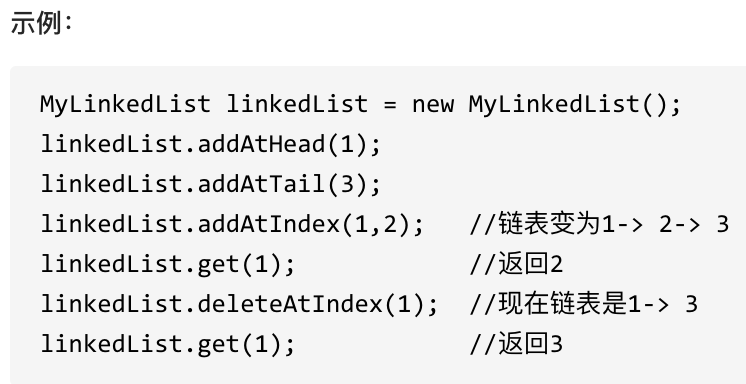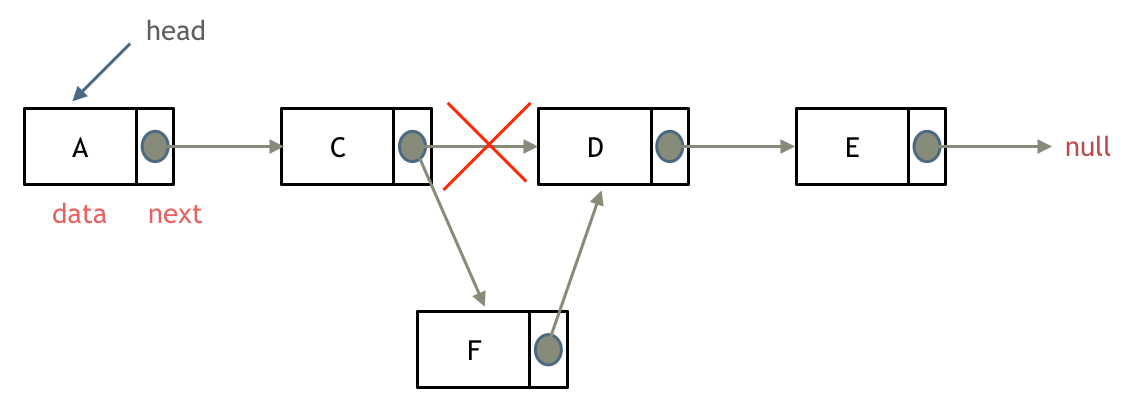# 707. Design Linked List
LeetCode problem link (opens new window)
Problem description:
Implement the following operations in your linked list class:
get(index): Get the value of theindex-th node in the linked list. If the index is invalid, return -1.addAtHead(val): Add a node of valuevalbefore the first element of the linked list. After the insertion, the new node will be the first node of the linked list.addAtTail(val): Append a node of valuevalto the last element of the linked list.addAtIndex(index,val): Add a node of valuevalbefore theindex-th node in the linked list. Ifindexequals the length of the linked list, the node will be appended to the end of the linked list. Ifindexis greater than the length, the node will not be inserted. Ifindexis less than 0, the node will be inserted at the head of the linked list.deleteAtIndex(index): Delete theindex-th node in the linked list, if the index is valid.

# Approach
If you are not familiar with the basics of linked lists, you can read this article: Linked List Basics (opens new window)
If you're not clear on the concept of dummy head nodes in linked lists, you can refer to this article: 0203.Remove Linked List Elements (opens new window)
Removing a node from the linked list:

Adding a node to the linked list:

This problem requires designing five interfaces for linked lists:
- Get the value of the
index-th node in the linked list - Insert a node at the head of the linked list
- Append a node at the tail of the linked list
- Insert a node before the
index-th node in the linked list - Delete the
index-th node from the linked list
These five interfaces cover the common operations for linked lists. This problem is a very good exercise for practicing linked list operations.
There are two approaches to operate on linked lists:
- Directly operate on the original linked list.
- Set up a dummy head node to simplify operations.
Below is an example using a dummy head node (this makes things more convenient, as you'll see from the code).
class MyLinkedList {
public:
// Define a structure for the linked list node
struct LinkedNode {
int val;
LinkedNode* next;
LinkedNode(int val):val(val), next(nullptr){}
};
// Initialize the linked list
MyLinkedList() {
_dummyHead = new LinkedNode(0); // This defines a dummy head node, not the actual head node of the list.
_size = 0;
}
// Get the value of the `index`-th node, return -1 if the index is invalid. Note that the index starts from 0, so the 0th node is the head.
int get(int index) {
if (index > (_size - 1) || index < 0) {
return -1;
}
LinkedNode* cur = _dummyHead->next;
while(index--){
cur = cur->next;
}
return cur->val;
}
// Add a node at the front of the linked list; the new node will become the new head of the list
void addAtHead(int val) {
LinkedNode* newNode = new LinkedNode(val);
newNode->next = _dummyHead->next;
_dummyHead->next = newNode;
_size++;
}
// Add a node at the end of the linked list
void addAtTail(int val) {
LinkedNode* newNode = new LinkedNode(val);
LinkedNode* cur = _dummyHead;
while(cur->next != nullptr){
cur = cur->next;
}
cur->next = newNode;
_size++;
}
// Add a `val`-valued node before the index-th node in the list
void addAtIndex(int index, int val) {
if(index > _size) return;
if(index < 0) index = 0;
LinkedNode* newNode = new LinkedNode(val);
LinkedNode* cur = _dummyHead;
while(index--) {
cur = cur->next;
}
newNode->next = cur->next;
cur->next = newNode;
_size++;
}
// Delete the `index`-th node in the linked list, if index is valid
void deleteAtIndex(int index) {
if (index >= _size || index < 0) {
return;
}
LinkedNode* cur = _dummyHead;
while(index--) {
cur = cur ->next;
}
LinkedNode* tmp = cur->next;
cur->next = cur->next->next;
delete tmp;
tmp=nullptr;
_size--;
}
// Print the linked list
void printLinkedList() {
LinkedNode* cur = _dummyHead;
while (cur->next != nullptr) {
cout << cur->next->val << " ";
cur = cur->next;
}
cout << endl;
}
private:
int _size;
LinkedNode* _dummyHead;
};
2
3
4
5
6
7
8
9
10
11
12
13
14
15
16
17
18
19
20
21
22
23
24
25
26
27
28
29
30
31
32
33
34
35
36
37
38
39
40
41
42
43
44
45
46
47
48
49
50
51
52
53
54
55
56
57
58
59
60
61
62
63
64
65
66
67
68
69
70
71
72
73
74
75
76
77
78
79
80
81
82
83
84
85
86
87
88
89
90
- Time Complexity: Related operations on
indexare O(index), the rest are O(1). - Space Complexity: O(n)
# Other Language Versions
# C++ Double Linked List Approach:
// Implemented using a circular virtual node double linked list
class MyLinkedList {
public:
// Define the structure of a doubly linked list node
struct DList {
int elem;
DList *next;
DList *prev;
DList(int elem) : elem(elem), next(nullptr), prev(nullptr) {};
};
// Constructor to initialize the linked list
MyLinkedList() {
sentinelNode = new DList(0);
sentinelNode->next = sentinelNode;
sentinelNode->prev = sentinelNode;
size = 0;
}
// Get the value of the `index`-th node in the linked list
int get(int index) {
if (index > (size - 1) || index < 0) {
return -1;
}
[Translation continues for other code versions...]
etc...
2
3
4
5
6
7
8
9
10
11
12
13
14
15
16
17
18
19
20
21
22
23
24
25
26
